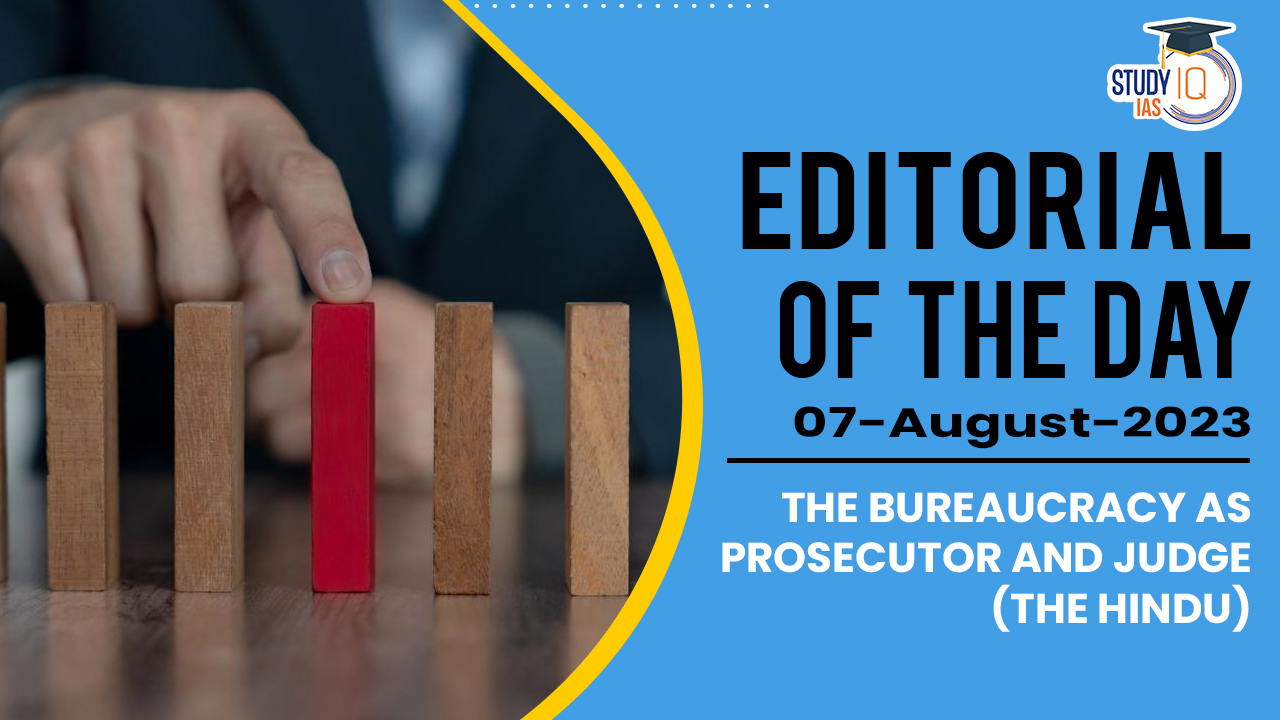Table of Contents
Context: The article is discussing the Jan Vishwas Act, which was enacted into law by the Indian Parliament in 2022. This Act is aimed at improving the “ease of doing business” in India by decriminalising or making certain offences “compoundable” under 42 legislations. The main concern highlighted in the article is that while the Jan Vishwas Act replaces criminal imprisonment with monetary penalties, it also transfers the power to impose these penalties from the judiciary to the bureaucracy. In other words, designated bureaucrats, such as Joint Secretaries, are given the authority to conduct inquiries, determine wrongdoing, and impose penalties of up to ₹15 lakh in certain cases under amended laws like the Environmental (Protection) Act, 1986, the Air (Prevention and Control of Pollution) Act, 1981, and the Indian Forest Act, 1927. The article questions the constitutionality of this arrangement, raising concerns about the separation of powers between the executive (bureaucracy), legislature (Parliament), and judiciary. The article therefore calls for a closer examination of whether this delegation of power to the bureaucracy is in line with the constitutional scheme and principles of governance.
Background
Doctrine of Separation of Powers:
- The Doctrine of Separation of Powers is a fundamental concept in democratic systems, aimed at dividing the powers and functions of the government into three distinct branches: the legislature, the executive, and the judiciary.
- Each branch is vested with specific powers and functions, and they are meant to act as checks and balances on one another to prevent the concentration of excessive power in any single branch.
- In India, Article 50 of the Constitution encourages the state to take steps to separate the judiciary from the executive, emphasising the importance of this principle.
- The Constitution sets forth the structure and defines the roles and functions of each organ of the State, establishing norms for their inter-relationships and checks and balances.
The Instruments of Checks & Balances in the Indian system are as follows:
- Legislature Control:
- On Judiciary: The legislature has the power of impeachment and removal of judges. It can amend laws declared ultra vires by the Court and revalidate them if required.
- On Executive: Through a no-confidence vote, the legislature can dissolve the government. It also exercises its control over the executive by assessing their work through mechanisms like the question hour and zero hour.
- Executive Control:
- On Judiciary: The executive has the authority to make appointments to the office of Chief Justice and other judges.
- On Legislature: The executive exercises control through delegated legislation, making rules for regulating their respective procedures and conduct of business, subject to the provisions of the Constitution.
- Judicial Control:
-
- On Executive: Judicial review empowers the judiciary to review executive actions to ensure they comply with the Constitution and don’t violate citizens’ rights.
- On Legislature: The doctrine of the basic structure, as pronounced by the Supreme Court in the Kesavananda Bharati case (1973), ensures that certain fundamental features of the Constitution cannot be amended by the legislature, protecting the essence of the Constitution.
Decoding the Editorial
- The article argues that allowing bureaucrats to be both the enforcers of the law and the adjudicators, who can impose penalties and order compensations, might be constitutionally suspect.
- The concern is that this concentration of power in the bureaucracy might undermine the principles of checks and balances, which are essential for a fair and just legal system.
Separation of powers:
The article discusses the concept of separation of powers in India and expresses concern about potential backsliding on this principle due to actions taken by the bureaucracy and the executive branch of the government.
- The Constitution of India does not explicitly mandate a strict separation of powers between the judiciary and the executive.
- However, Article 50 of the Constitution directs the state to work towards achieving such separation over time.
- The initial achievement of this separation occurred only after several years of independence, with the separation of the criminal magistracy from the executive.
- The article goes on to describe three different routes that the bureaucracy has taken to encroach upon judicial powers:
- Creation of judicial tribunals: Various Ministries established judicial tribunals to assume judicial functions previously handled by the judiciary. These tribunals were structured in a way that allowed bureaucrats to be appointed as “technical members,” which raises concerns about the independence of these tribunals.
- Establishment of statutory regulators: The government created regulatory bodies with the power to impose fines on the private sector, such as the Securities and Exchange Board of India and the Competition Commission of India (CCI). Many of these regulators ended up being headed by senior bureaucrats, raising questions about their impartiality and independence.
- Introduction of adjudicatory officers: The government introduced adjudicatory officers within various legislations, such as the Prevention of Money Laundering Act, the Information Technology Act, and the Food Safety and Standards Act. These officers, who were bureaucrats, were given the power to impose penalties or confirm attachment orders for properties, potentially blurring the line between executive and judicial functions.
- The Jan Vishwas Act is highlighted as an example that perpetuates this trend by creating “adjudicatory officers” within the bureaucracy to impose penalties.
- The concern is that allowing bureaucrats in charge of enforcing the law to also conduct inquiries and impose penalties could be constitutionally problematic and goes against the principles of the rule of law and separation of powers.
- The article raises the question of whether the imposition of penalties can be considered a “judicial function.”
- While there is significant case law on whether penalties are civil or criminal in nature, there is a lack of clear judicial precedent on whether the imposition of penalties qualifies as a judicial function.
- The article argues that any process involving fact-finding, application of the law to the facts, and determining punishment or compensation should be considered a judicial function, and thus, the burden should lie on an independent judge to ensure a fair trial before any punishment is imposed.
Broader Concern:
The broader concern expressed in the article is that India might be regressing in terms of upholding the separation of powers principle due to the persistent efforts of the bureaucracy and the executive branch to encroach upon judicial powers. The article suggests that elected Ministers’ indifference or lack of awareness about this issue might contribute to the erosion of the separation of powers and the fundamental principles of a democratic and just society.
Beyond the Editorial
There are some issues with the implementation of the Doctrine of Separation of Powers in India:
- Weakened Opposition: In India, the dominance of a single party in the Lok Sabha has weakened the role of an effective opposition, which is crucial for providing checks and balances in a parliamentary system.
- Judiciary Averse to Checks & Balances: The Supreme Court’s rejection of the National Judicial Appointments Commission (NJAC) showed a reluctance to subject the judiciary to external checks and balances, despite potential benefits in enhancing the appointment process.
- Judicial Activism: Some critics argue that the judiciary has sometimes engaged in “judicial activism,” where it goes beyond its traditional role of interpreting laws and rules, and instead makes decisions that resemble the domain of the legislature and executive.
- Executive Excesses: The executive has faced criticism for centralising power, weakening public institutions, and passing laws that may strengthen law and order but also restrict freedom of expression and civil liberties.


 Bharat Bandh 9 July 2025: Over 25 Crore ...
Bharat Bandh 9 July 2025: Over 25 Crore ...
 UPPSC Mains Question Paper 2025: Downloa...
UPPSC Mains Question Paper 2025: Downloa...
 Sukhoi Su-57: Will India Choose Russia�...
Sukhoi Su-57: Will India Choose Russia�...





















